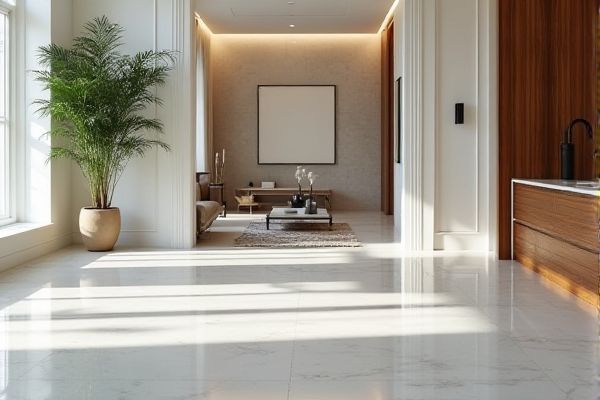
High-gloss floors create a sleek, reflective surface that enhances light and makes spaces appear larger, while matte floors offer a subtle, understated elegance that conceals scratches and dirt more effectively. Discover how your choice between high-gloss and matte flooring can impact your home's style and maintenance by reading the rest of the article.
Table of Comparison
| Feature | High-Gloss Floor | Matte Floor |
|---|---|---|
| Appearance | Shiny, reflective surface that brightens rooms | Non-reflective, smooth, and understated finish |
| Maintenance | Shows scratches and dirt easily; requires frequent cleaning | Hides scratches and dirt well; easier upkeep |
| Durability | Prone to visible wear, scratches, and scuffs | More forgiving to everyday wear and tear |
| Slipperiness | Can be slippery, increasing fall risk | Better traction for enhanced safety |
| Room Impact | Enhances brightness and spacious feel | Creates cozy, modern, and subtle ambiance |
| Best Use | Ideal for formal spaces and modern interiors | Suitable for high-traffic areas and casual settings |
Introduction to High-Gloss and Matte Floors
High-gloss floors feature a reflective, shiny surface that enhances natural light and creates a sleek, modern aesthetic popular in contemporary interior design. Matte floors offer a subdued, non-reflective finish that hides scratches and dirt more effectively, providing a warm, understated elegance preferred in rustic or minimalist spaces. Both flooring types vary in maintenance requirements, durability, and visual impact, influencing their suitability for different room types and design preferences.
Visual Appeal: Shiny vs. Subtle Finish
High-gloss floors reflect light intensely, creating a vibrant, mirror-like surface that enhances room brightness and accentuates architectural details. Matte floors offer a subtle, non-reflective finish that hides imperfections and provides a more natural, understated aesthetic. Choosing between shiny and subtle finishes depends on desired ambiance and maintenance preferences.
Durability and Maintenance Considerations
High-gloss floors typically require more frequent cleaning to maintain their reflective shine, as they easily show dust, scratches, and smudges, making durability a crucial consideration for high-traffic areas. Matte floors offer better resistance to scratches and imperfections, often requiring less maintenance and making them ideal for busy households or commercial spaces. Your choice should balance aesthetic preference with the level of upkeep you're willing to commit to ensure long-lasting floor performance.
Scratch and Stain Resistance
High-gloss floors typically offer superior stain resistance due to their smooth, sealed surfaces that prevent liquids from penetrating. In contrast, matte floors can better conceal scratches and scuffs because their textured, non-reflective finish hides imperfections more effectively. Both finishes require specific maintenance to preserve their resistance qualities, with high-gloss needing frequent polishing and matte benefiting from routine gentle cleaning.
Slip Resistance and Safety Factors
High-gloss floors tend to be more slippery, especially when wet, increasing the risk of slips and falls compared to matte floors, which offer better slip resistance due to their textured surface. Matte floors provide enhanced safety in high-traffic or moisture-prone areas, making them ideal for homes with children or elderly residents. Choosing your flooring with slip resistance in mind ensures a safer environment and reduces the likelihood of accidents.
Light Reflection and Room Brightness
High-gloss floors reflect significantly more light, enhancing room brightness and creating a spacious, airy feel. Matte floors absorb more light, resulting in a softer, more subdued ambiance that minimizes glare and hides imperfections better. Your choice depends on whether you prefer a vibrant, luminous environment or a warm, understated atmosphere.
Cleaning and Upkeep Differences
High-gloss floors highlight dust, dirt, and streaks more than matte floors, requiring more frequent cleaning to maintain their shiny appearance. Matte floors effectively hide smudges and imperfections, making them easier to upkeep with less intensive cleaning routines. Your choice between the two will impact how often you'll need to clean and the visibility of wear over time.
Best Settings for High-Gloss Floors
High-gloss floors require cleaning tools and settings that minimize streaks and enhance shine, such as microfiber mops and gentle, non-abrasive cleaners with a neutral pH. Use automated floor scrubbers with adjustable suction and soft brush settings to prevent scratches while maintaining a reflective surface. Optimal air drying and low humidity environments help preserve the high-gloss finish by preventing moisture spots and dulling.
Ideal Spaces for Matte Flooring
Matte flooring is ideal for high-traffic areas such as kitchens, hallways, and living rooms where durability and slip resistance are essential. Its non-reflective surface effectively conceals scratches, dirt, and smudges, making it a practical choice for busy households and commercial spaces. Matte floors also complement rustic, industrial, and contemporary interior designs by providing a subtle, understated elegance that enhances texture and color depth.
Choosing the Right Finish for Your Lifestyle
High-gloss floors reflect light and create a sleek, polished look ideal for modern interiors, but they may show scratches and dirt more easily, making them better suited for low-traffic areas or meticulous maintenance routines. Matte floors offer a subtle, natural appearance that hides imperfections and dirt, perfect for busy households or spaces demanding a more forgiving finish. Your choice between high-gloss and matte floors should balance aesthetic preferences with practical considerations like durability and cleaning habits.
 homyna.com
homyna.com